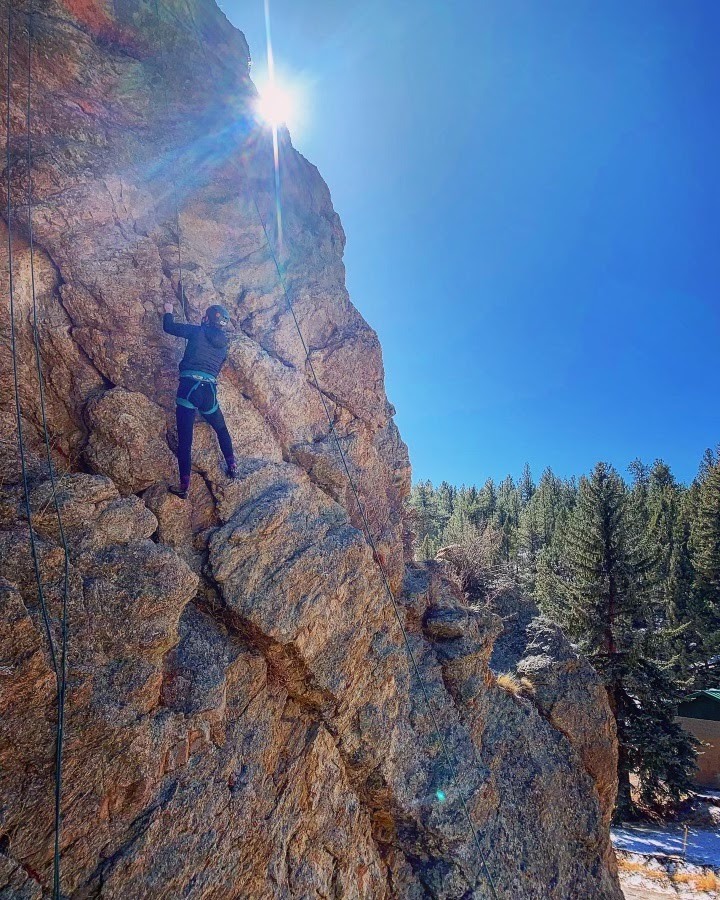
On Wednesday March 10 after an introduction to geology and rock types from one of our instructors, Dan, we traveled to Eleven Mile Canyon for an in-depth climbing experience with the Front Range Climbing Company. While it was barely above freezing, we spaced ourselves amongst the volunteer drivers and made way for Eleven Mile. Upon arrival, we noticed four top-ropes were set up, and while all of us were freezing, we were eager to get warm quickly. Following a quick introduction, we all claimed the ropes and roped ourselves in for the coldest climb we will ever experience. As heard from numerous students, no one was sure if they were grabbing a secure hold or grabbing nothing, mostly due to our freezing fingers. On the contrary, William S. ‘21 and Mr. Calhoun made it to the top of the most difficult route with ease. After we wrapped up our climbing, we were tasked as four groups to see who can be the highest grade 3-piece anchor (can be any device or method for attaching a climber, a rope, or a load to the climbing surface) with the strength to haul a load through the use of pulley systems and mechanical advantage. Each group was given various camelots, nuts, rope, and a select few cracks to build their anchors. When building an anchor we have been following the acronym SERENE, which means, Solid (in terms of the crack and placements of the devices), Equalizing (is the anchor self-equalizing, meaning depending on the climbers movements, does the rope equalize with the mass), Redundant (if one strand or carabiner were to break would the whole anchor fail), Efficient (is the anchor time efficient and effective), and No extension (if one piece were to fail, we don’t want the anchor to extend its length a lot if not at all). With this in mind, our four groups built excellent anchors with grades ranging from B-minus to an and A-plus. Building anchors is not easy and it is certainly a skill that comes with a lot of practice, and thanks to Mr. Calhoun and our guides, we were all able to build “bomber” anchors that had no trouble hauling heavy loads.
On Thursday March, 11th, we stayed on campus to have a lesson on geology thanks to Arlo F. Niederer. With his expertise, he taught us the ins and outs of important geological concepts. We learned of key theories, principles, and laws that guide geologists in their investigation of the wonders of Earth’s complex rock systems. Plate tectonics, continental drift, the geologic time scale, and rock dating were just a few of the concepts we were introduced to. Additionally, Arlo gave us an intensive look at topographic/geologic maps and structural geology, the practical elements of the all intensive field of geology. We learned how to read the maps, their significance, and their implications in structural geology. Finally, we ended with an analysis of the layers of Earth as well as the tools geologists use to map their Earth deep below our feet. To practice with these topics, Arlo gave us activities, tasking us with ordering rock layers by relative age using geologic laws; reading geographic maps in order to determine rock age, fault locations, and the creation of geologic formations; and using pressure, temperature, density and sonic wave data to map the depth ranges of the different layers of the Earth. We left the classroom that day, brains full of new geologic knowledge that we could apply to our climbing endeavors.
On Friday March 12, we learned some more about geology with Arlo leading the charge. He taught us how to identify rocks. Our first activity was looking at the crystal systems which are complex yet intriguing. Then we learned about the hardness and different cleavages of rocks. We observed various different hardness levels using the Mohs hardness scale, diamond being a 10 (the hardest), and talc being the softest at a 1. As for cleavage, we looked at different ways rocks break, and whether or not they break with pieces cleaving, or by fracturing into many pieces. Finally, most of this knowledge was more or less foreign to most students, but thanks to Arlo, we were able to get a better understanding of the Earth and its geological aspects.



